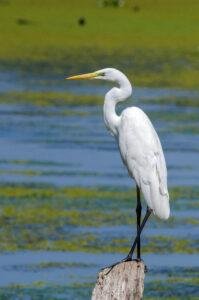The Great Egret (Ardea alba), also known as Great White Egret, Common Egret, Large Egret or Great White Heron, is a large, widely-distributed egret. Distributed across most of the tropical and warmer temperate regions of the world, in southern Europe it is rather localized. In North America it is more widely distributed, and it is ubiquitous across the Sun Belt of the United States and in the rainforests of South America. It is sometimes confused with the Great White Heron of the Caribbean, which is a white morph of the closely related Great Blue Heron (A. herodias).
The Great Egret is a large heron with all-white plumage. Standing up to 1 m (3.3 ft) tall, this species can measure 80 to 104 cm (31 to 41 in) in length and have a wingspan of 131 to 170 cm (52 to 67 in). Body mass can range from 700 to 1,500 g (1.5 to 3.3 lb), with an average of around 1,000 g (2.2 lb). It is thus only slightly smaller than the Great Blue or Grey Heron (A. cinerea). Apart from size, the Great Egret can be distinguished from other white egrets by its yellow bill and black legs and feet, though the bill may become darker and the lower legs lighter in the breeding season. In breeding plumage, delicate ornamental feathers are borne on the back. Males and females are identical in appearance; juveniles look like non-breeding adults. Differentiated from the Intermediate Egret (Mesophoyx intermedius) by the gape, which extends well beyond the back of the eye in case of the Great Egret, but ends just behind the eye in case of the Intermediate Egret. It is a common species, usually easily seen.
It has a slow flight, with its neck retracted. This is characteristic of herons and bitterns, and distinguishes them from storks, cranes, ibises, and spoonbills, which extend their necks in flight.
The Great Egret is not normally a vocal bird; at breeding colonies, however, it often gives a loud croaking cuk cuk cuk.
Like all egrets, it is a member of the heron family, Ardeidae. Traditionally classified with the storks in the Ciconiiformes, the Ardeidae are closer relatives of pelicans and belong in the Pelecaniformes instead. The Great Egret—unlike the typical egrets—does not belong to the genus Egretta but together with the great herons is today placed in Ardea. In the past, however, it was sometimes placed in Egretta or separated in a monotypic genus Casmerodius.
Subspecies
There are four subspecies in various parts of the world, which differ but little. Differences are bare part coloration in the breeding season and size; the largest A. a. modesta from Asia and Australasia some taxonomists consider a full species, the Eastern Great Egret (Ardea modesta).:
- Ardea alba alba (Europe)
- Ardea alba egretta (Americas)
- Ardea alba melanorhynchos (Africa)
- Ardea alba modesta (India, Southeast Asia, and Oceania)
- The Great Egret is partially migratory, with northern hemisphere birds moving south from areas with colder winters. It breeds in colonies in trees close to large lakes with reed beds or other extensive wetlands. It builds a bulky stick nest.The Great Egret is generally a very successful species with a large and expanding range. In North America, large numbers of Great Egrets were killed around the end of the 19th century so that their plumes could be used to decorate hats. Numbers have since recovered as a result of conservation measures. Its range has expanded as far north as southern Canada. However, in some parts of the southern United States, its numbers have declined due to habitat loss. Nevertheless, it adapts well to human habitation and can be readily seen near wetlands and bodies of water in urban and suburban areas. In 1953 the Great Egret in flight was chosen as the symbol of the National Audubon Society, which was formed in part to prevent the killing of birds for their feathers.The Great Egret is one of the species to which the Agreement on the Conservation of African-Eurasian Migratory Waterbirds (AEWA) applies.
On 22 May 2012, it was announced a pair of Great Egrets were nesting in the UK for the first time at the Shapwick Heath nature reserve in Somerset. The species is a rare visitor to the UK and Ben Aviss of the BBC stated that the news could mean the UK’s first Great Egret colony is established. The following week, Kevin Anderson of Natural England confirmed a Great Egret chick had hatched, making it a new breeding bird record for the UK. Anderson commented “We’ve definitely seen one chick stretching a wing just before the adult arrived and also after it left and we continue to monitor for more. The eggs of the Great White Egret can hatch over a period of a few days so it may be that if there are other young on the nest they will be less developed and won’t be visible yet.”
- The Great Egret feeds in shallow water or drier habitats, feeding mainly on fish, frogs, small mammals, and occasionally small reptiles and insects, spearing them with its long, sharp bill most of the time by standing still and allowing the prey to come within its striking distance of its bill which it uses as a spear. It will often wait motionless for prey, or slowly stalk its victim.

- The Great Egret is depicted on the reverse side of a 5-Brazilian reais banknote.White Egrets is the title of Saint Lucian Poet Derek Walcott’s fourteenth collection of poems.The Great Egret is the symbol of the National Audubon Society.
- The name of venerable Shariputra, one of the Buddha’s best known followers, signifies the son of the egret (among other possibilities), it is said that his mother had eyes like a great egret.




